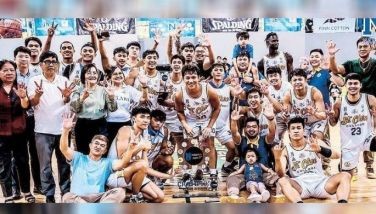De las Alas: Small man with a tall shadow
Some days back, Mark Joseph of the Philippine Olympic Committee (POC) wrote Pacita (Ching) de las Alas-Montinola about his attending, together with POC president Jose Cojuangco Jr, the inauguration of the new Olympic Council of Asia (OCA) headquarters in February 2009 in Kuwait. Ching is one of two surviving daughters (the other is Carmencita “Menchu” Concepcion) of the late Antonio de las Alas, former president of the Philippine Amateur Athletic Federation (PAAF). De las Alas formed the PAAF in 1911 upon his return from his US studies in law (Bachelor of Laws from Indiana University and Master of Laws, cum laude, from Yale University) together with Elwood Brown and other Manila residents.
Cameron Forbes, then Governor-General of the Philippines served as the PAAF’s first president until 1918. Manuel L. Quezon took over from Forbes and was PAAF president for 17 years. De las Alas was vice president to Jorge Vargas of the PAAF from 1935 to 1955.
De las Alas was president from 1955 to 1968, when Ferdinand Marcos decided to intervene in Philippine sports by causing the election of his own people to Philippine sports then highest position: De las Alas happened to be the father-in-law of Sen. Ambrosio Padilla (married to one of de las Alas’s daughters, Lourdes or Lily), top-ranking official of the opposition Liberal Party.
Joseph emphasizes that several heads of state and the world’s top sports leaders, including Dr. Jacques Rogge, president of the International Olympic Committee, were in Kuwait. Joseph, president of the swimming National Sports Association, says the OCA headquarters is a state-of-the-art, multi-million dollar complex which has two six-star hotels (owned by OCA) adjacent to it. That is how big and powerful the Asian Games are, according to Joseph. He adds that Qatar spent US$4 billion to host the 2006 Asian Games.
A source of pride for the two officials was the slide show that presented the history of the Asian Games and two earlier attempts to launch it: in 1913, as the Oriental Games and again in 1932, as the Far Eastern Games. Playing a prominent role as a pioneer of the second largest international multi-sport event after the Olympics was the Philippines.
Joseph says that he and Cojuangco could not be prouder to be Filipinos as global sports leaders in Kuwait expressed their admiration for the Philippines as the nation, which conceived the Asian Games.
Back in Manila from Kuwait, Joseph did some research to figure out what made that golden era in Philippine sports possible. He concluded that a number of men, among them de las Alas, was responsible for that glorious period which was interrupted, as Joseph points out, by Marcos’s political intervention. Joseph, an Olympian, claims that after de las Alas was ousted by Marcos, there was a slump in the Philippines Olympic and Asian Games medal outputs. It was, Joseph says, “a classic case of politics (government intervention) ruining sport”. Joseph points out that “during de las Alas’s incumbency, the Philippines won more Asian Games medals (especially gold) than after he was replaced by Marcos. The same for the Olympics: during de las Alas’s incumbency, the Philippines produced more than half of all Filipino Olympians to date, including the 15 that qualified in 2008 (in Beijing)”.
For a man his size, de las Alas indeed took on king-sized jobs for sports. The accounts of Ching and Menchu state that the demands of being both a public school student in the morning and a teacher in the afternoon, left the frail and sickly looking, 79-pound de las Alas little time for sports. He had failed, in his first try, the physical examination required of all government students wishing to study in America. After he passed the examination and, while at Indiana, he devoted a good deal of his time to athletics. He took up tennis, baseball, track and cross-country running and, later, basketball. He worked in the quarry carrying heavy rocks and pulling wheelbarrows to improve his built and physical stamina. His rigorous and methodical training paid off when he became a member of the track and field team and boxing champion of the university.
Together with Vargas, de las Alas is credited with initiating the construction of the Rizal Memorial Stadium and the nearby athletic field. De las Alas is also known to have introduced cycling, the poor man’s sport, and table tennis in the Philippines.
As a tribute to de las Alas, his biography called “The Small Man With a Tall Shadow” will be launched tomorrow at the Philippine Columbian Association, Plaza Dilao, Paco at 6 p.m. Given the versatility of de las Alas, the book promises to be a highly fascinating account of Philippine sports, politics, industry and business.
- Latest
- Trending



























